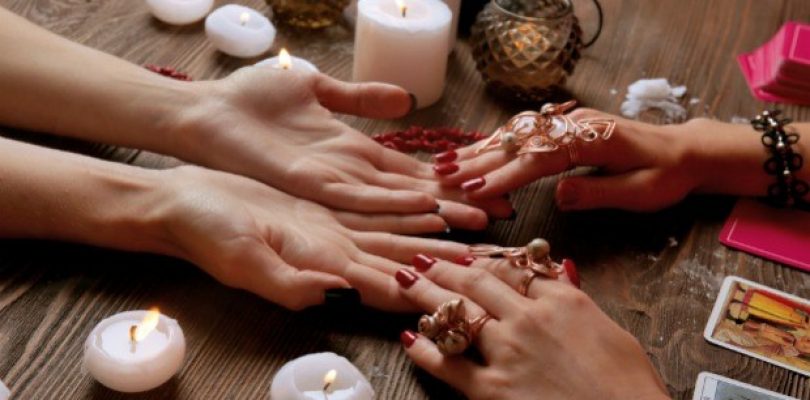Palm reading, also known as palmistry or chiromancy. Palmistry began in ancient India, and spread throughout the Eurasian landmass to China, Tibet, Persia, Egypt, and Greece. It’s a worldwide art of understanding a person’s personalities, fortune and future by analyzing his/her hands.
There are different schools of thought on which hand to read. Some schools say that if you want to have insight into your work life and how you present yourself to the world, focus on your dominant hand. But look to the non-dominant hand for insight into personal relationships, dreams, and emotional struggles.
The left hand usually indicates what you were born with physically and materially and the right hand refers to what you become after grown up. So, the right hand is dominant in palm reading and the other is passive.
In palmistry, there are mainly three major lines to read which are Life Line, Head Line, and Heart Line .

The Heart Line
This line can be read from the pinkie finger to the index finger or vice versa depending on the tradition being followed. It refers to emotional stability, romantic perspectives, depression, and cardiac health.
A line that begins below your index finger means that you’re content with your love life.
A line that begins below your middle finger shows that you’re selfish in areas of love.
A line that begins in the middle of your hand tells that you fall in love easily.
A short and straight line shows that you have less interest in romance than many people.
A long and curvy line indicates that you freely express your thoughts and feelings.
A line that touches your life line demonstrates that your heart is broken easily.
A line that runs straight and parallel to your head line refers to your good control of your emotions, your stability, and your approachable demeanor.
A line curving upward represents your verbal dexterity and your ability to speak about love and feelings.
A line curving downward shows your inability to express your feelings and your weak character.
A wavy line indicates your various relationships but your lack of serious relationships.
A circle or an island, on your line represents sadness or depression in your life.
If your love line has many circles means that you are sentimental and potentially involved in many emotional entanglements.
A broken line indicates that you have experienced emotional trauma.
Smaller lines crossing your heart line marks further emotional trauma.
A doubled love line shows your ability to express love and accept two different relationships at once.
The Head Line
It is one of the most important lines you have on your palm. It begins at the edge of your palm between the forefinger and the thumb, and it extends across the palm between heart line and life line.
A short line that only reaches your middle finger reflects your preference for physical tests and achievements over mental tasks, and being sometimes careless or hasty in your decisions.

A long line that extends to under your little finger indicates that you have a clear mind, and you’re considerate toward others.
A line of medium length, which reaches your ring finger, is the most common and indicates that you’re smart and have great potential.
A line separated clearly from the life line reflects your enthusiasm for life and adventure.
A wavy line marks your various interests and your short attention span.
A circle or a cross in the line marks sort of emotional crisis affecting your thoughts.
Having multiple crosses in your line, means that you face many important decisions.
A broken line indicates that you have many inconsistencies in your thoughts.
A line that curves steeply downward reflects your very strong imagination and artistic talent, but being easily influenced by your emotions.
If the end of your head line is close to your heart line, it means that you’re good at creating and maintaining personal relationships.
If your head line and your life line overlap, then you’re more thoughtful and introverted.
If your head line is far apart from your life line, it indicates that you’re bold, extroverted and highly independent.
A star on your head line refers to the fact that you may be hurt or you may suffer from headaches.
A star near your head line but not on it reflects your great wisdom.
If you have a doubled head line, you’re exceptionally strong mentally.
The Life Line

It begins near the thumb toward the wrist. This line is responsible for showing the physical health and general well-being of an individual, including major life changes.
A line that runs close to the thumb means that you’re often very tired.
A line that is strongly curved indicates your exceptional energy.
A line that reaches near your wrist and that is cut deeply into your palm marks your vitality.
A short and shallow line shows that others easily manipulate you.
A big, long curve in a semicircle represents your strength and enthusiasm for life.
A straight line that almost reaches the end of your palm reflects your caution in relationships.
Multiple life lines mean that you have extra vitality.
A circle on your life line refers to a time when you were injured or hospitalized.
A break in the line shows that you’ve had a sudden change in your lifestyle.
The Fate Line
The fate line is the final major palm line; but not everyone has one, so this may not be applicable to all of your palm readings. It shows how much one’s life is affected by circumstances beyond his or her control.
A deep line indicates that you’re strongly controlled by fate.
A line with breaks or sudden changes in direction means that you’re subject to many life changes.
A line that begins to join the life line shows that you’re self-created individual with many dreams.
A line that begins at the base of the theme and crosses the life line represents your family’s and friends’ support.
A line that is ended at the heart line shows that your career is affected by your emotions.
The four elements of palmistry
There are four major types of hand shapes. You should start with your hand’s shape before looking at lines and finger shapes.
Knowing the type of palm you are examining will help you recognize the types of lines you see. For example, earth and water hands usually feature deeper lines than those on air or fire hands. These features can help you locate information in the palm that you are examining.
The Earth Hand
The earth hand takes strongly square shape of the palm and fingers. Length of the palm equals length of fingers, and the skin is thick and ruddy in color.
People with earth hands tend to be more Practical and responsible, and sometimes materialistic. They also energetic and can be stubborn sometimes.
The Air Hand
The air hand is also be square, but it is rectangular in shape with long fingers and low-set thumbs. Dry skin; and length of the palm less than length of fingers
People with air hands are very curious and intellectual, they prefer to read and to learn through study. They are Sociable, talkative and witty. They also can be shallow and cold. They tend to do things differently, as they have their unique ways.
The Water Hand
The water hand has an oval-shaped palm, with long and flexible fingers; length of the palm equals the length of fingers.
Those with water hands tend to be Creative, perceptive and sympathetic. They can be moody, emotional and inhibited. Introverts, and they also do things quietly and intuitively.
The Fire Hand
The fire hand has fingers that are shorter than the square or rectangle created by the palm, and most fire hands are either flushed or pink in skin color.
People with fire hands are spontaneous, enthusiastic and optimistic. They can be short-tempered and impatient, but sometimes egoistic, impulsive and insensitive. They are extroverts and tend to do things boldly and instinctively.




